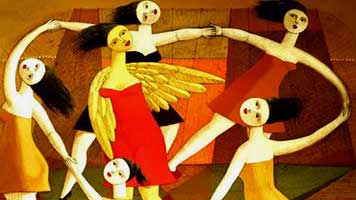|
Felix Berroa

I was born in a small city in the Dominican Republic. That city is San Pedro de Macoris. To speak of San Pedro de Macoris is to speak of sugar cane. The sugar cane is the main economic source of this country. San Pedro de Macoris get the size of town in 1822. First name for this town was "Mosquitisol". Word made from two situation there: "mosquito" and "sol" (sun). Late get the actual name of San Pedro de Macoris.
The name of "Macoris" had its reminiscences from the Indians "Macorix" of the region. The foundation of the sugar mills started around 1852. San Pedro de Macoris is the city of most cultivation of sugar cane and millwork in the Dominican Republic. The city has six enormous sugar cane mills. The city reached a flourishing economy when its sugar production enjoyed high prices in the traditional market as result of the First World War. That flourishing economy brought Europeans and other immigrants from different parts of the world: Spain, Jew, Arab, Italy, German, French, Lebanese, Syrian, Venezuela, China, Holland, Cuba, Puerto Rico, Turk, etc. They settled in San Pedro de Macoris making it a very cosmopolitan urban city. Pan American flew its hydroplanes in a regular schedule, at a time when this city enjoyed more commercial activity than the capital city Santo Domingo.
Some sugar cane mills are property of the state and other privates. To speak of sugar cane in the Dominican Republic is to speak of "cutting by hand the sugar cane", of arduous works, of continuous perspiration, of extreme physical exhaustion, of not well paid works and of housing with poor structures and very bad sanitary facilities. For that reason, the Dominicans refused to work there. With this personnel's crisis (no personnel to cutting the sugar cane in the field, and work in the mill factory), the owners of these sugar mills rather than increase the wages and to improve the conditions of the population's housing settled in it outskirts, appealed to import, each year, cheap hands works from Haiti and the English Caribbean islands as St. Kitts and Navis, St. Thomas, Anguila, Antigua, Tortola, etc. The immigrants of these English islands spoke English, for what were called "ingleses" (Englishmen), and disparagingly, "cocolos". They were strong and very hard working (if you observe the last name of some of the black Dominican baseball players in the American Big League, will find names as Ricardo Carty, Jorge Bell, Alfredo Griffin, etc.) The "Ingleses" or "Cocolos" bring their culture, they food.
The dance of the "buloya", is one of them. Beside the sugar cane, San Pedro de Macoris was also recognized by it great poets, until the point of being won the nickname of "City of the Poets". Some of the greater poet from that city are: Federico Bermudez y Ortega (1895-1968), Gaston Fernandez Deligne (1861-1913), Virgilio Diaz Ordonez (1895-1968), Francisco Dominguez Charro (1910-1943), Pedro Mir (1913-2000), Pedro Andres Perez Cabral (1913-1981), Freddy Gaston Arce (1920), Victor Manuel Villegas (1924), Rene de Risco Bermudez (1937-1972), etc. A son of San Pedro de Macoris was the great colossus of the poetry in the Dominican Republic, Don Pedro Mir. (The country calle him "Don" for respect and admiration). What is Walt Whitman for the North American, is it Don Pedro Mir for the Dominicans. His poetry quality and the strong identification with the "national" thing were so intense, that a former president of the country (Juan Bosh), grant him with the title "NATIONAL POET" of the Dominican Republic. This great poet, was professor at the Universidad Autonoma de Santo Domingo, UASD, of "Aesthetic I", "Aesthetic II", and "Theory and Arts Critique". I was his student in all three subjects. What honor, have been a Pedro Mir student!!! Is already a long time ago San Pedro de Macoris leave behind of being the "City of the Poets" to become "The City of the Baseball Players". Many of the Dominican baseball players are contracted by the United States BIG LEAGUES (the dream of all baseball player).
The Dominican Leagues have their championships in around the winter, maybe to be adjusted to the Big League itinerary, whose celebration are during the summer. When the Big League Championship in USA finished, the Dominican baseball players returns to their home town during the winter, triumphant, showing the shine of their economic abundance, product of their juice contracts: jewels, good clothes, luxurious cars, construction of mansion, etc. Almost always, as good Dominicans, between their first priorities, is the construction of their parent's house. This abundance motivated many children and young's male from San Pedro de Macoris (and the rest of the country) to giving their self deeply to the baseball games, arising a great number of excellent players of great abilities and skills.
Some names of baseball player from San Pedro de Macoris are: Sammy Sosa, Ricardo Carty, Julio Cesar Franco, Pedro Guerrero, Joaquin Andujar, Alfonso Soriano, Jorge Bell, Alfredo Griffin, Rafaelin Ramirez, Julio Cesar Franco, Tony Fernandez, Jose Offerman, Antonio Alfonseca, Esteban Yan, Julio Lugo, Manny Alexander, Solomon Torres, etc. Others from differents part of the country are: Juan Marichal, Pedro Martinez, Bladimir Guerrero, Felipe Alou, Jesus Alou, Mateo Alou, Moises Alou, Tony Peña, Cesar Cedeño, Manuel Mota, Melvin Soto, Pedro Martinez, Ramon Martinez, Bartolo Colon, Jose Mesa, Armando Benitez, Miguel Tejada, Alex Rodriguez, Manny Rodriguez, Albert Pujols, Raul Mondesi, David ortiz, Jose Lima, Bladimir Guerrero, Odalis perez, Octavio Dotel, Rafael Furcal, Luis Polonia, Neifi Perez, Juan Samuel, etc. If you like baseball, you know those names! There is about sixty or seventy Dominicans baseball players more. So much was the fame of San Pedro de Macoris producing good baseball players that the United Stated Big League teams having their own baseball school there and in other part of the country. Example: School of Baseball of the Yankis, School of Baseball of the Angels, etc.
|

